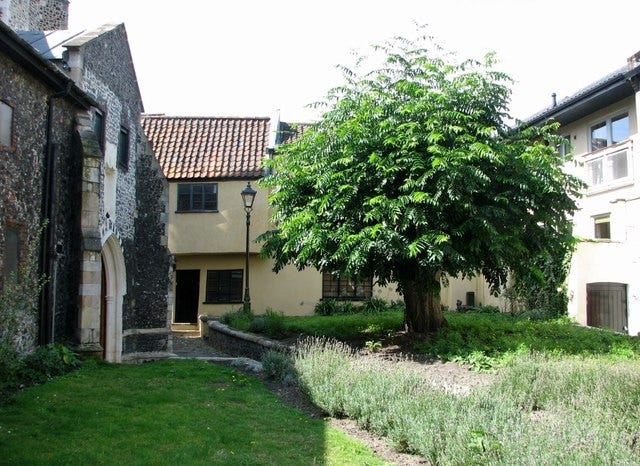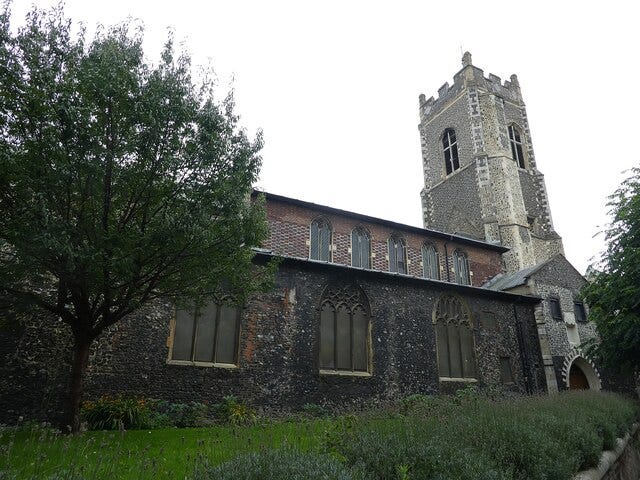Tombland. See it, feel it, embrace it. And let it do the same to you. (Shutterstock)
Tombland.
A dark sepulchral place. The very epitome of other-wordly...
A place for the dead.
You’d be excused of thinking all of those things if you were a first time visitor to Norwich, that finest of cities, one that gently drew this quote from novelist and playwright J.B.Priestly;
What a grand, higgledy-piggledy, sensible old place Norwich is!
In that wonderfully ‘higgledy-piggledy’ way of our City, Tombland has got little to nothing to do with death or a burial ground. Because the name comes from two old English words that roughly translate as ‘open ground’ or ‘empty space’. In the case of Norwich, this ‘open ground’ was seen as being the ideal location for the city’s main market place, an area that, far from one rather too easily connected with all things dark and dismal was, infact, the hub of Norwich’s burgeoning commercial activity and day to day life and had been long before the Normans came, saw and decided to conquer back in 1066.
The Normans certainly liked the look of Norwich. It was prosperous, it sat upon a river and the land around it was rich and fertile.
‘Une Belle Ville’ as Herbert de Losinga might have said. He wasn’t a local but a man born in Exmes, Normandy who, as Bishop of Thetford, founded Norwich Cathedral in 1096.
That didn’t stop him doing what so many incomers to Norfolk see fit to carry out almost immediately upon arrival however.
Tombland was where the impressive palace of the Earl of East Anglia had been built, a mighty Saxon pile that dated from around 850 AD.
Down that came as did the equally imposing St Michaels Church which was, up until the arrival of the Norman version of a wrecking ball, the biggest church in Norwich.
To de Losinga, dispensing with these two iconic Saxon buildings came as easily as you or I might take out and replace the kitchen or bathroom when we move home.
He wanted bigger and better, as did the Normans. More to the point, they wanted Norwich to look more like home.
Hence the Cathedral, of course, as well as the Castle and its keep, which is built almost exclusively of expensively imported Caen stone.
No chalk or flinty rubble here, thankyou very much. We’re Normans you know.
Tombland, in short, was now looking rather different.
Calm. But that has not always been the case. Tombland Alley. (Evelyn Simak/geograph)
Yet, and against the odds, it continued to be one of the focal points of city life, despite its now rather more stern, some might say austere appearance, watched over, as it was, by those two icons of Norman rule.
Yet Tombland remained lively, and even, at times, a bit feisty…
It saw a riot on 1272 when, at the annual horse fair, a squabble between the monks who inhabited the Cathedral Priory and the good folk over Norwich led to a full on running battle, all precipitated, it is believed, by a long running disagreement over who could do what in certain parts of Norwich-in this case, Tombland.
The monks saw the area as an extension of the Cathedral grounds, a place of reflection, contemplation, piety and modesty.
Whilst the locals still regarded it as a thirteenth century version of the Prince of Wales road (ie) a meeting point for celebration, revelry and bawdy behaviour in general.
Things got nasty.
The people of Norwich’s ire had been well and truly stoked by claims that one of their number had been brutally murdered by a monk who, unsurprisingly, they wanted to see brought to justice through the King’s (it was Henry III at the time, a notoriously pious monarch who, you feel, might have been inclined to side with the monks) courts.
“Pah!”, replied the monks to this claim, adding, “Your secular justice system has no power over clerics. We are judged by God and God alone, not your silly King”.
Any thoughts the monks might have had about that being an end to the matter were, you won’t be surprised, soon stopped in their tracks.
Rightfully aggrieved at such a sleight, the locals response was not, as might have been expected, to tug their forelocks whilst offering a hurried apology (‘…we know our place, masters, we wun’t do it ‘agin”) before scurrying back to their homes because, rather than do that, they retaliated by firing burning arrows from the tower of Tombland’s St George Church over the Cathedral walls.
Today’s Church of St George in Tombland. (Rob Farrow/geograph)
This resulted in the bell tower being burnt as well as substantial damage to the priory buildings. In addition to that, the interior of the church of St Ethelred was destroyed.
The Prior’s answer to this insubordination?
To run away as fast as he could to Great Yarmouth where he gathered a band of easily bought mercenaries who, upon their arrival back in Norwich with the Prior, commenced running battles with the locals.
Things got so serious that, in the end, the King was informed about the affair and, God-fearing a man that he was, he came down on the side of the monks-those very same monks who had previously mocked his position and right to have any say in their affairs or that of the church.
His stance ultimately led to thirty of Norwich’s leading citizens being executed whilst a fair few more were heavily fined, an altogether sad and very unsatisfactory conclusion to a dark period in the cities life.
And with it ended, the first, but, by no means, the only battle of Tombland. For, as calm and refined as it may look today, all cobbled streets, hip cafes and views that many a TV and film producer has swooned over, its story is rich, colourful and, as this salutary tale has shown, one that has seen its fair share of violence over the centuries.
A part of Norwich that is so rich in history, you can feel it reaching out to embrace you.
Especially on icy cold December nights…






